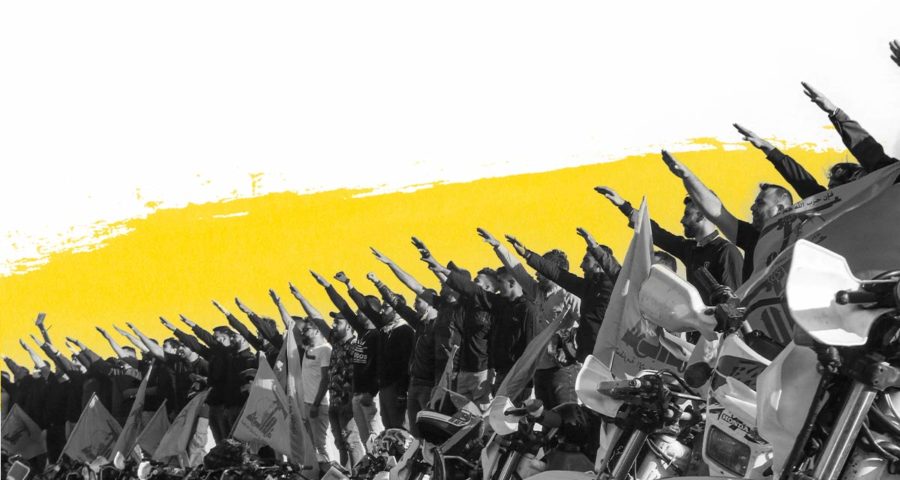
Founded in 1982 by a group of young Shi’a militants, Lebanese Hezbollah (the “Party of God”) was the product of an Iranian effort to aggregate under one roof a variety of militant Shi’a groups in Lebanon, themselves the products of the domestic and regional instability of the time. Hezbollah was the outgrowth of the country’s complex and bloody civil war. For the first time, Lebanon’s historically marginalized Shi’a Muslims attempted to assert economic and political power. A 1984 CIA report notes that “Iran began to develop close links with Lebanese Shias soon after the Israeli invasion in June 1982. Some 800 Revolutionary Guards were sent to Lebanon through Syria to help recruit Hezbollah, provide political and religious indoctrination and military training, including instruction in terrorist tactics.”
In 1987, the CIA assessed that “an Islamic fundamentalist movement probably would have developed in Lebanon without outside support, but Iranian aid has been a major stimulant.” Shortly after the Israeli invasion, hundreds of IRGC advisors and trainers set up a base in the Bekaa Valley with the goal of exporting the Islamic revolution to the Arab world. Hezbollah Deputy Secretary-General Naim Qassem recalls how training camps supervised by the IRGC were set up in the Bekaa Valley as early as 1982 and how all members were required to attend these camps and learn how to confront the “enemy.”
In its early years, Hezbollah functioned as a “network of radical Shia paramilitary groups that agree[d] on major strategic goals such as the establishment of an Islamic republic but often differ[ed] on tactical or operational matters.” These militant networks were typically organized around specific family clans, such as the Musawi and Hamadi families.
In 1985, Hezbollah identified the organization’s ideological platform: “We view the Iranian regime as the vanguard and new nucleus of the leading Islamic State in the world. We abide by the orders of one single wise and just leadership, represented by ‘waliyat el faqih’ [guardianship of the jurist] and personified by [Iranian Supreme Leader Ayatollah Ruhollah] Khomeini.” Hezbollah has been Iran’s proxy ever since, and it is estimated that Iran provides Hezbollah with as much as $700 million-1 billion per year.
Hezbollah Development as an Iranian Proxy
Despite its foundation as a Lebanese political party, Hezbollah has always profited from Iran’s material and ideological support. The close alignment between Iran and Hezbollah was exemplified early on by the latter’s “name game.” Hezbollah adopted the alias of the Islamic Jihad Organization to give it “a modicum of plausible deniability,” muddling its relationship with Iran. As early as 1983, the CIA observed that Islamic Jihad “more likely is a cover used by Iran for its terrorist operations, whether employing local Shias in Lebanon or locally recruited agents of other nationalities” and that “[s]urrogates provide Iran with an excellent means for creating the illusion that an independent, international organization is at work against U.S. interests.”
Soon, the U.S. intelligence community would collect information, later declassified, underscoring the close relationship between Hezbollah, its Islamic Jihad terrorist wing, and Iran. For example, instructions from Iran’s Ministry of Intelligence to Lebanese terrorists in 1985 urged them to conduct a propaganda campaign in the name of Islamic Jihad, an event the National Intelligence Council found to be “the first definite link” between the Iranians and Islamic Jihad.
Throughout the 1980s, Iran and Hezbollah continued to seek a degree of public separation by means of using the alias Islamic Jihad, but CIA reports definitively established Islamic Jihad was Hezbollah, not some rogue militant group.
Islamic Jihad started off as a loosely organized group, but Iran helped it coalesce into the organized group we now know as Hezbollah. In March 1984, the CIA assessed that “Tehran could change the present character of ‘Islamic Jihad’ from a loose association of largely independent, irregularly organized Shiite factions into a more formalized, international organization.”
Indeed, this predicted formalization and professionalization of Hezbollah into a full-fledged arm of Iran’s terrorist apparatus occurred through an influx of money, weaponry, personnel, military and explosives training, and tactical guidance. Iranian embassy officials were responsible for coordinating radical Shi’a activities within Lebanon at the behest of the Iranian senior leadership. The Iranian ambassador in Damascus and the IRGC commander in the Bekaa Valley worked closely with the Council of Lebanon, an Iranian-created committee of radical Lebanese Shi’a leaders, to coordinate all fundamentalist activities in Lebanon.
Some Iranian “auxiliaries” were even embedded in Hezbollah units in the Bekaa Valley, with the IRGC sharing Hezbollah’s communications and support network. Nor was the symbiotic relationship between Iran and Hezbollah premised purely along the military and terrorism dimension.
Hezbollah also adheres the ideological, cultural, and religious tenets of the Iranian Revolution and the guardianship of the jurist, waliyat al-faqih. Hezbollah extremists “responded with zeal to Khomeini’s revolutionary message.”
The group shared a desire to establish a fundamentalist state and export it worldwide. In fact, early expansion in Hezbollah’s base was likely due to the popular preaching of Iranian-trained clerics and a “fanatical devotion to Ayatollah Khomeini and the cause of sparking an Islamic revolution in Lebanon,” the CIA concluded.
Shi’a religious hierarchy in Lebanon was tightly bound to Iran, “historically in both a religious and kinship sense.” Lebanese clerics received training in Iran, married into Iranian clerical families, and acted as mouthpieces and amplifiers of Iranian theological discourse, with the revolution “providing a well-formulated extremist ideology and a model for Shia fundamentalist activism.”
Beyond the educational and familial pathways, Iranian ideology permeated Lebanon by means of official channels. In addition to providing paramilitary and terrorist skills, the IRGC in Lebanon provided political and religious indoctrination. Thus, the CIA concluded in 1987, although “an Islamic fundamentalist movement probably would have developed in Lebanon without outside support […] Iranian aid has been a major stimulant.”
Over the years, U.S. government sources have variously referred to Hezbollah and its leaders as a “surrogate,” “puppet,” “the vanguard of an Iranian-influenced revolutionary movement,” and “Iran’s most important and longest-standing non-state partner and a core member of Tehran’s ‘Axis of Resistance.’
Nonetheless, Hezbollah developed even from its earliest days along two often overlapping but sometimes competing tracks.
For all of their pro-Iranian spirit, Hezbollah’s leaders also sought to create an independent, domestic movement aligned with Iran but independent to make its own decisions. While considering itself “a part of the Islamic nation in the world,” the organization’s founding statement said it intended “to determine our fate by our own hands.”
U.S. government sources were well aware of Hezbollah’s chimeric attitude: “The Hizballah movement does not depend on Iran for its existence. Shia fundamentalism, whetted by decades of Shia deprivation and a brutal Israeli occupation, has firmly taken root in Lebanon and has achieved a momentum of its own,” the CIA observed in a 1985 report. Although a ceasing of Iranian support to Hezbollah would slow the latter’s growth, Hezbollah could satisfy its material needs on its own, if the need arose. Hezbollah was also asserting independence of action, carrying out operations without Iranian foreknowledge.
In an assessment of Iranian sponsorship of terrorism, the CIA found “mounting evidence that the Lebanese Shias—although respectful of Khomeini and the Iranian revolution—will no longer tolerate Iranian attempts to dictate their policies.”36 Case in point was the release of hostages. Tehran would be unlikely to be able to force Hezbollah to free all its hostages in Lebanon, particularly when the proxy’s goals did not coincide with Tehran’s. Hezbollah, it seemed, had “become an autonomous
terrorist problem in its own right.” Mohammed Hussein Fadlallah, Hezbollah’s foremost cleric in the group’s early years, was particularly adamant about maintaining autonomy from Iran. Fadlallah maintained that the “revolutionary circumstances” in Iran were fundamentally different than those in Lebanon, and that Hezbollah would consult with — but not pander to — Iran.39 Following Syria’s occupation of West Beirut in February 1986, Fadlallah went so far as to block Hezbollah from executing Tehran’s order to attack the Syrians.40 As a result, Iranian leaders “circumvent[ed]
Fadlallah’s authority by dealing directly with Hizballah officials through the Iranian embassies in Beirut and Damascus and through the Iranian Revolutionary Guard contingent in the Bekaa Valley.”
Over time, Fadlallah fell out of favor with Tehran, and within Hezbollah leadership circles, over his refusal to subscribe to the Iranian concept of waliyat al-faqih. But one of Fadlallah’s proteges, Imad Mughniyeh, who founded the group’s Islamic Jihad terrorist unit, frequently consulted with Iranian intelligence and IRGC officials, according to U.S. intelligence sources. An Iranian official sat on the Hezbollah Shura Council in 1992, and around the same time two Iranian officials were members of Hezbollah’s military committee.
The IRGC ran Hezbollah’s intelligence planning section until 1989, when a Lebanese candidate was finally deemed capable of doing the job. Over the years, senior IRGC-QF and Ministry of Intelligence and Security (MOIS) officials would periodically visit Lebanon to work with Hezbollah and assess the group’s security. And when Mughniyeh wanted to target U.S. interests, he would seek Iranian consent. For example, in December 1991 the CIA worried over intelligence suggesting that Hezbollah planned to attack U.S. interests in Beirut in the ensuing weeks.
Iran would likely oppose more Hezbollah kidnappings, the CIA assessed, since Tehran wanted to preserve its political capital from the recent release of some hostages. However, the agency warned, “It is possible that Tehran has approved lowlevel terrorist operations against US interests—such as sniper attacks—to allow Hezbollah elements to vent their animosity toward the United States. These Hezbollah elements may include former hostage holder Imad Mughniyeh.”
Two decades after the U.S. Marines barracks bombing, testimony in U.S. federal court established that Hezbollah carried out the bombings with Syrian and Iranian oversight. According to the testimony of former U.S. military officials, two days after the bombing — on October 25, 1983 — the chief of naval intelligence notified the deputy chief of naval operations of an intercepted message from September 26, 1983, just a few weeks before the barracks bombing. Sent from MOIS in Tehran, the message instructed the Iranian ambassador in Damascus, Ali Akbar Mohtashemi, to contact Hussein al-Musawi and to direct him to “take spectacular action against the United States Marines” and the multinational coalition in Lebanon.
In the words of Col. Timothy Geraghty, commander of the Marine unit in Beirut at the time of the bombing, “If there was ever a 24-karat gold document, this was it. This is not something from the third cousin of the fourth wife of Muhammad the taxicab driver.”
U.S. signals intelligence had caught Iranian officials instructing a Hezbollah leader to carry out an attack targeting U.S. Marines in Lebanon, but the military bureaucracy prevented that information from getting where it needed to be in time to prevent the attack.
Years later, a former Hezbollah member would testify in a U.S. federal court case that Ambassador Mohtashemi followed orders and contacted an IRGC member named Kanani, who commanded its Lebanon headquarters.
Mughniyeh and his brother-in-law, Mustafa Badreddine, were named operation leaders after a meeting that included Kanani, Musawi, and thenHezbollah security official Hassan Nasrallah. Planning meetings were held at the Iranian embassy in Damascus, often chaired by Ambassador Mohtashemi, who helped establish Hezbollah in the first instance.

